URLsLab’s suite of optimization tools plays a pivotal role in improving website performance. Featuring URL monitoring, seamless redirects, web vitals analysis, code injection capabilities, and much more, this suite is designed for technical professionals seeking to enhance site efficiency and user experience.
This article provides a detailed analysis of each feature’s technical specifications and benefits, demonstrating how URLsLab meets complex website management needs.
URL monitoring feature
The URL Monitoring feature enables you to detect broken links leading to non-existent or invalid URLs and hide them to protect your website’s integrity. This gives you complete control over what appears on your website. Additionally, it provides a comprehensive overview of all internal and external links used on your website and allows tracking of any changes made to your URLs.
You can see all the links discovered on your website during page generation in a clear table. A background cron process assesses the accessibility of each link to your visitors. By enabling the link validation feature, the plugin will automatically check and report all broken links, giving you an opportunity to fix them promptly.
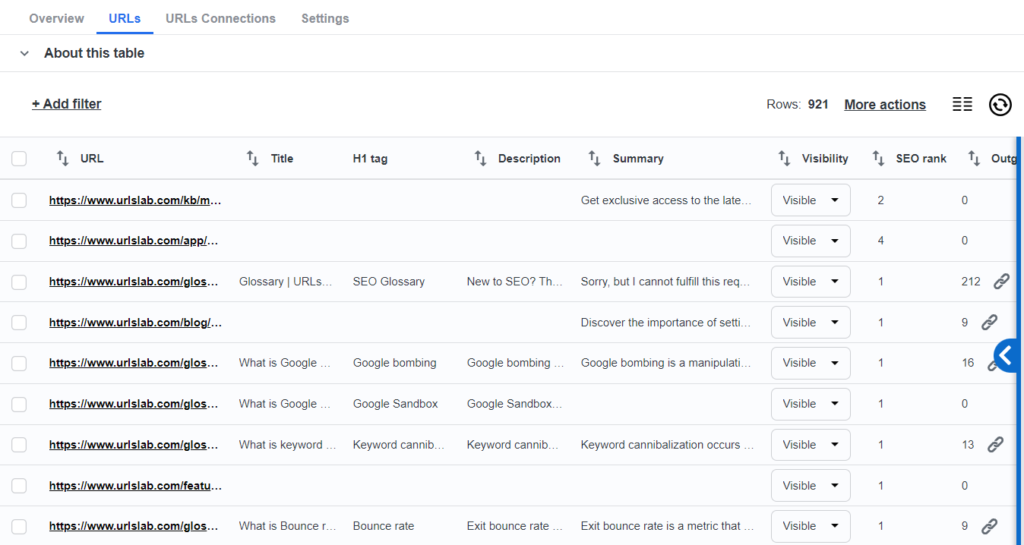
Clicking on “Show changes” will take you to the page changes section, which provides valuable insights into performance metrics such as the crawl and change date, word count, page size, page load duration, and page requests for each URL modification. By monitoring these metrics, website owners and marketers can analyze the impact of changes on performance and user experience.
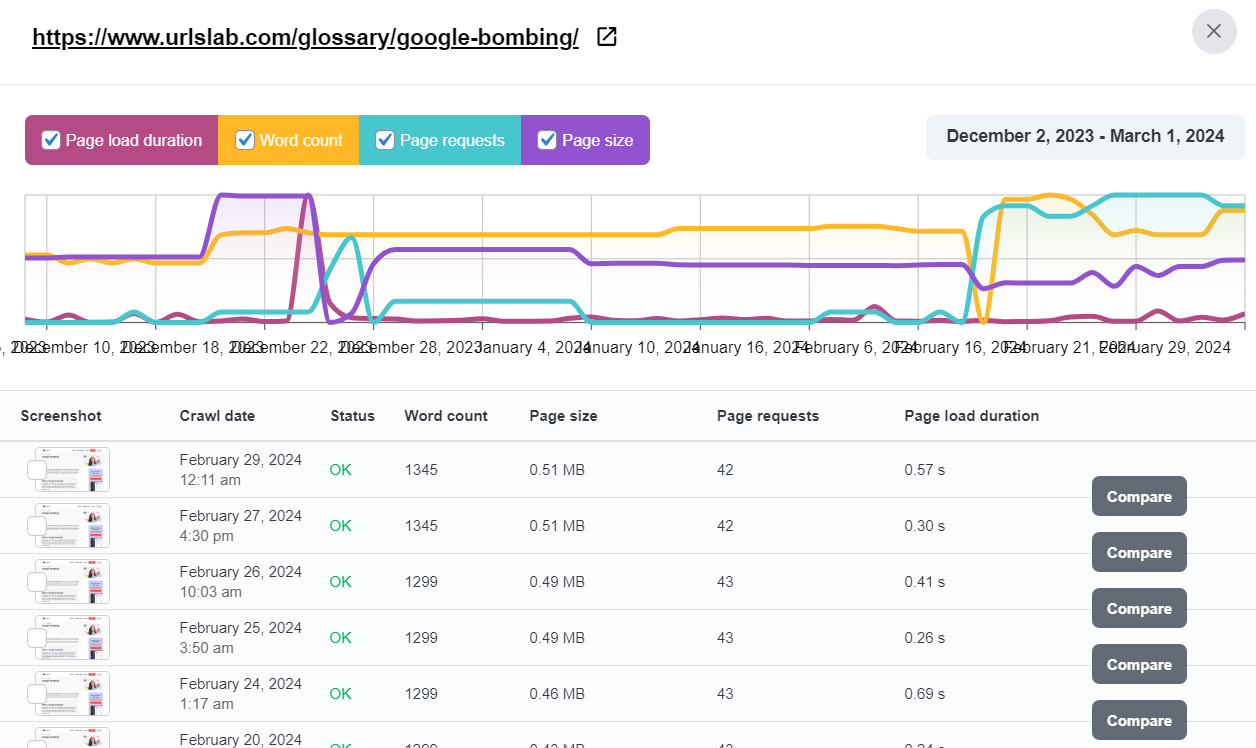
To learn more, read the full article about our URL monitoring feature, which includes a practical guide and basic settings.
Redirects feature
The Redirects feature in URLsLab is designed to help users easily manage all their redirects in one place without the need to manually alter the .htaccess file on a server. With permanent or temporary redirects, you can always ensure that your website visitors land on the correct page, keeping them engaged.
In the Redirects tab, you can see a table displaying the match types, URLs, redirect to, HTTP codes, created, redirects count, and tags. You can also filter through this table for easier navigation. Clicking on the pencil icon will let you edit the existing redirect.

To learn more, read the full article about our Redirects feature, which includes a practical guide and basic settings.
Web vitals feature
Web Vitals is an analytical tool designed to assess website performance, focusing on critical metrics, such as Load Time (LCP), First Input Delay (FID), Cumulative Layout Shift (CLS) and more. These metrics are integral to comply with Google’s performance standards, thereby influencing search engine ranking.
The Web Vitals feature systematically gathers real user performance data, aligning with Google’s evaluation criteria. This process facilitates the identification and resolution of issues impacting Core Web Vitals scores.
For optimal database performance, it is recommended to limit the duration of detailed log storage on production environments, utilizing this feature primarily for short-term diagnostic purposes. Instead, it should be used only for short-term monitoring to identify any issues.
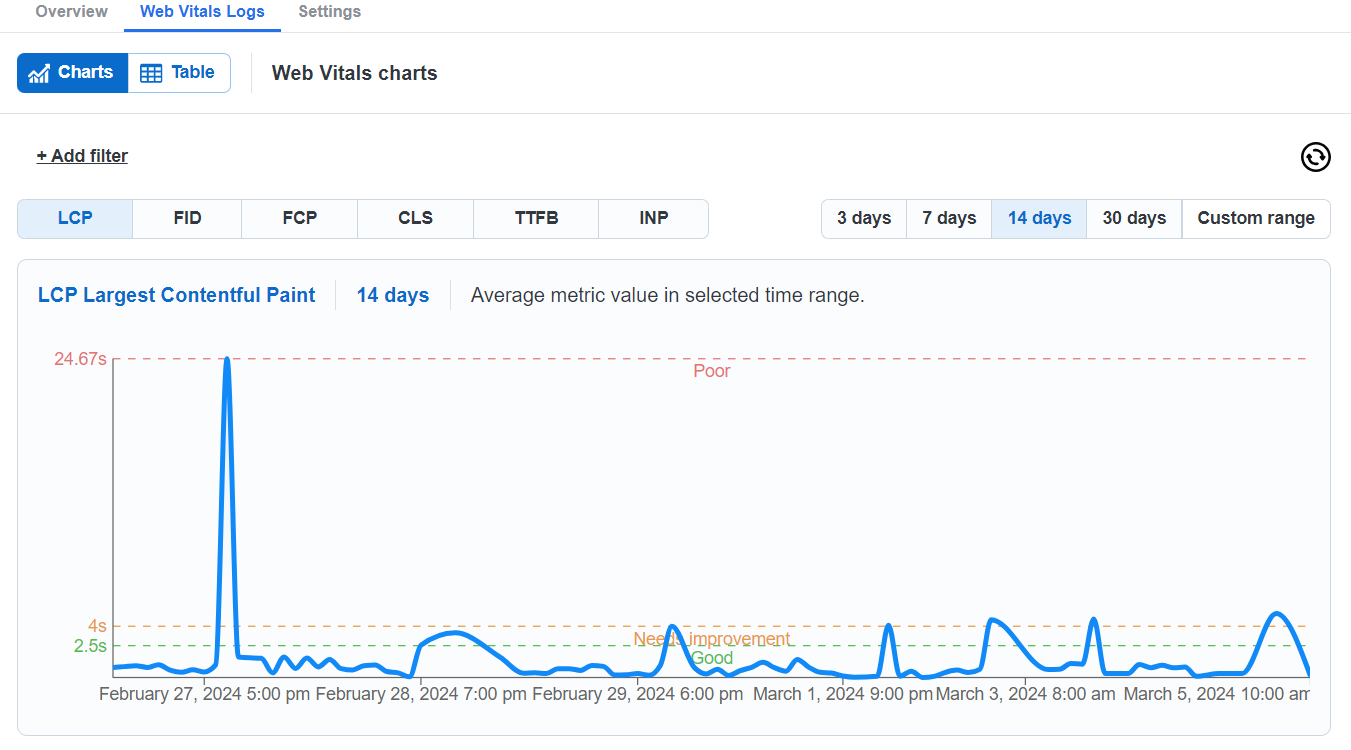
Users can also display the table, an alternative format of presentation and apply advanced filters to identify specific URLs with issues. This feature is particularly beneficial as URLsLab provides a more detailed analysis compared to GSC
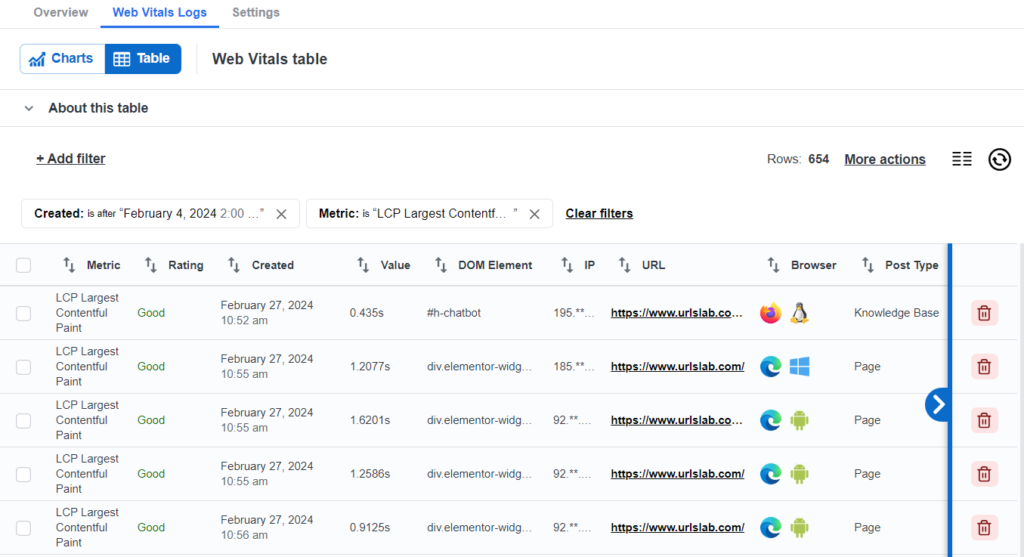
Search and replace feature
The Search and Replace feature can be used for various purposes, from replacing incorrect URLs to correcting typos in your content quickly and efficiently, without much manual effort. It also offers the possibility of reversing all changes that were made at any time, without making permanent changes to your database.
You can see all the replacement rules in a simple table under the “Replacements” section. As the page content is generated, these rules are applied to all HTML requests in real time. If a rule’s conditions are met, all corresponding strings will be changed according to that rule’s parameters.

However, it’s important to note that this dynamic process does not modify the original content in the database. If the module or a specific rule is deactivated, the plugin reverts to displaying the original content.
You can edit each row by clicking on the small pencil button on the left. Choose whether you want the method for string matching to be a “plain text” or a “regular expression” and then enter a string or regular expression for replacement and the substitute string.
To learn more, read the full article about our Search and replace feature, which includes a practical guide and basic settings.
Code injection feature
The URLsLab Code Injection feature revolutionizes the way you integrate and manage code on your website. The process is broken down into several key steps.
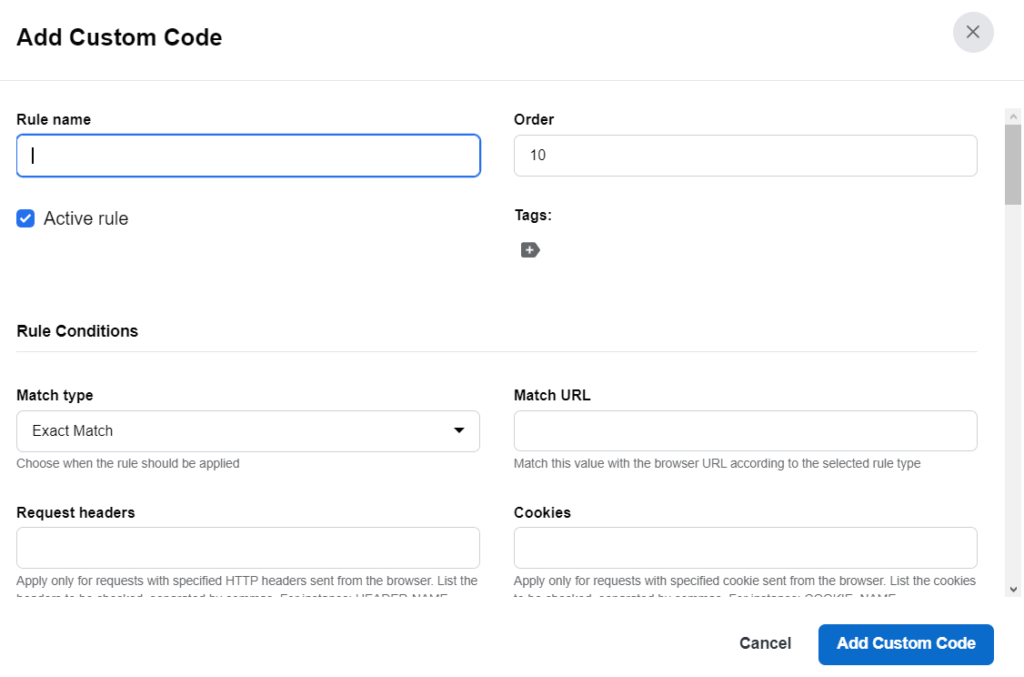
Targeted insertion
The first phase of the Code Injection feature involves identifying the specific areas of your web pages where you want the custom code to take effect. With precision, you can target key HTML landmarks within your pages, such as “right after the “, “just before the “, “immediately following the “, or “just before the ” tag.
This strategic placement ensures that your code executes exactly where and how you need it to.
Custom code implementation
Once you’ve pinpointed the insertion spots, the feature allows you to inject custom HTML, CSS, or JavaScript code directly into these areas. This step is designed for ease and efficiency; simply paste your custom code into the provided fields, and it’s set to run across all pages.
This functionality not only saves time but also maintains a consistent behavior or style throughout your site.
Intelligent application
The Code Injection feature enhances precise code management with an “About this table” section, detailed within the user interface as shown in the image. This segment provides a comprehensive guide on setting specific conditions for your code injections, ensuring that your custom scripts perform as expected on selected pages or site-wide.
It lists existing rules and allows for the addition of new ones, defining where and when each piece of code should execute. By doing so, it guarantees that the custom code only impacts the intended areas, avoiding any unwelcome side effects on your website’s functionality or design.
To learn more, read the full article about our Code injection feature, which includes a practical guide and basic settings.
Database optimizations feature
URLsLab’s Database Optimizations feature can automatically delete post revisions, auto-draft posts, and posts in the trash, thereby freeing up space and resources. Additionally, it removes expired transient options and orphaned data stored in the database, which leads to improved system efficiency. These optimization processes can significantly boost website speed and performance
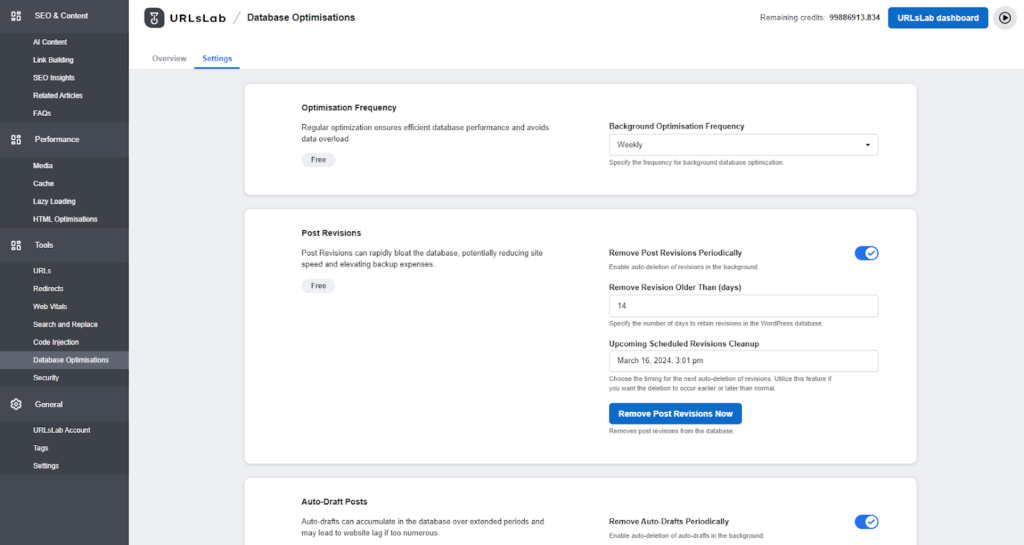
URLsLab’s Database Optimization feature consist of various elements:
- Optimization frequency: To schedule the frequency of your database optimization, choose from the drop-down menu in the Background Optimization Frequency. The optimization can be done daily, weekly, monthly, or quarterly.
- Post revisions: In this section, you can toggle on the post revisions maintenance functionality. Turning on the “Remove Post Revisions Periodically” option will enable the process of auto-deletion of revisions in the background.
- Auto-draft posts: To schedule the automatic periodic maintenance of auto-draft posts, enable “Auto-Draft Posts” in the Settings menu. The next cleanup can be scheduled for a specific date and time.
- Trashed posts: To set up the automatic cleanup of thrashed posts, activate the Trashed Posts functionality and specify the number of days you wish to retain trashed posts in the WordPress database, as well as the exact date and time for the next cleanup.
- Transient options: In this section, you can set up a separate cleanup process for transient options and expired transient options.
- Orphaned relationship data: Perform regular maintenance and remove the orphaned data that accumulates over time in your database, taking up significant space.
- Orphaned comments data: When you frequently remove comments from your WordPress website, they accumulate over time and occupy a significant amount of database space.
- URLsLab temporary data: The URLsLab plugin stores some temporary data in the database, primarily for debugging purposes. This data should also be periodically deleted to free up space.
To learn more, read the full article about our Database optimization feature, which includes a practical guide and basic settings.
Security feature
This feature is designed to protect your website against cyber threats, malware, spam, and hackers. The primary goal is to keep your website and its data safe, secure, and functioning optimally.
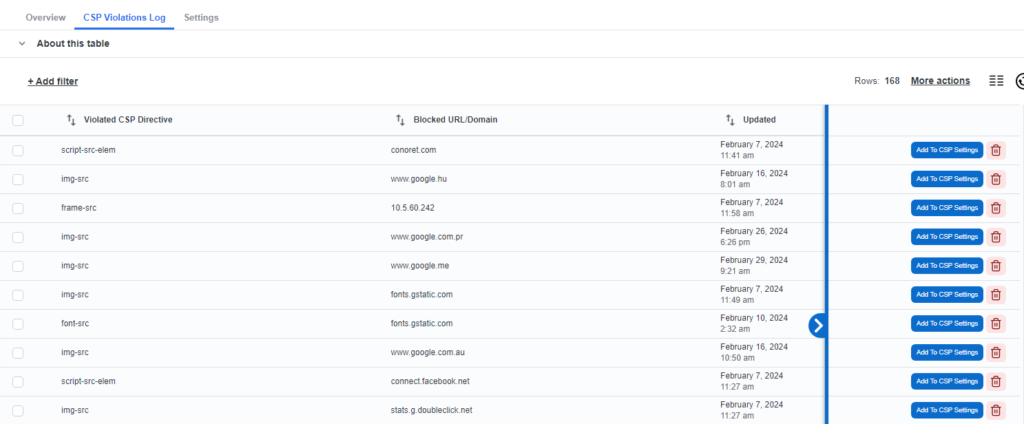
URLsLab can protect you from:
DDoS attacks (Distributed Denial of Service)
A DDoS attack on a WordPress site, originating from a single IP, can strain server resources by directing an excessive amount of requests to both valid and non-existent pages. This not only disrupts service availability but also negatively impacts website performance. Implementing security measures like IP-based rate limiting and real-time monitoring is vital to mitigate such threats.
Mitigating cross-site scripting
Content Security Policy (CSP) primarily aims to reduce or prevent XSS (Cross-Site Scripting) attacks by enabling server admins to define trusted domains for running executable scripts. This blocks potentially harmful scripts from untrusted sources. To maximize security, CSP can be used to entirely forbid script execution, offering protection against XSS attacks.
Mitigating packet sniffing attacks
For enhanced security, servers can not only determine the permitted domains for content loading but also require secure protocols like HTTPS. Thorough data security strategies include enforcing HTTPS, using secure attributes for cookies, and automatically redirecting HTTP to HTTPS. The use of the Strict-Transport-Security HTTP header ensures browsers communicate with sites solely through encrypted connections.
To learn more, read the full article about our Security feature, which includes a practical guide and basic settings.
Supercharge your website with URLsLab
Enhance functionality, improve efficiency, and watch your website thrive. Unlock the key to success for your website – try URLsLab now!
Get the WordPress plugin
Subdomains are crucial for organizing and structuring websites, improving navigation, and boosting SEO. They come in different types and should align with overall SEO strategy. Efficient use and consideration of user experience are key. URLsLab offers advanced features for optimizing meta descriptions and enhancing website visibility.
Subdomains are crucial for organizing and structuring websites, improving navigation, and boosting SEO. They come in different types and should align with overall SEO strategy. Efficient use and consideration of user experience are key. URLsLab offers advanced features for optimizing meta descriptions and enhancing website visibility.
Lazy loading, offered by URLsLab, is a crucial technique for optimizing website performance. It reduces initial page load times, conserves bandwidth, and enhances user experience. URLsLab's comprehensive Lazy Loading module provides customizable options for implementing lazy loading on WordPress websites, including image, video, and YouTube lazy loading. This technique is essential for improving page loading times, saving bandwidth, and enhancing SEO performance.



